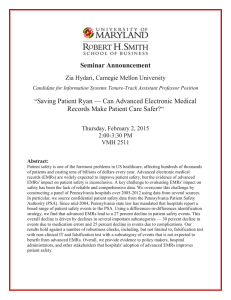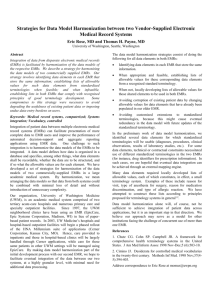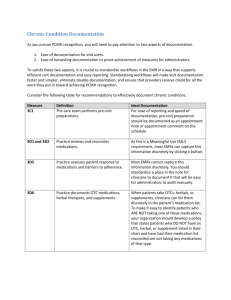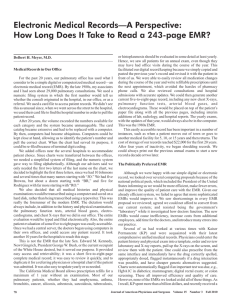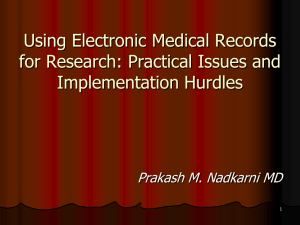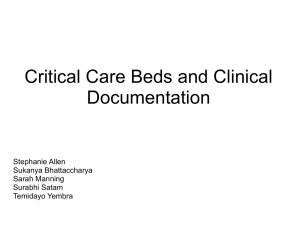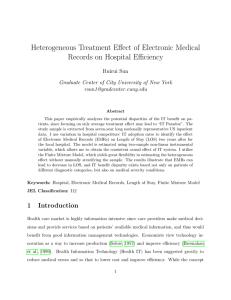File
advertisement
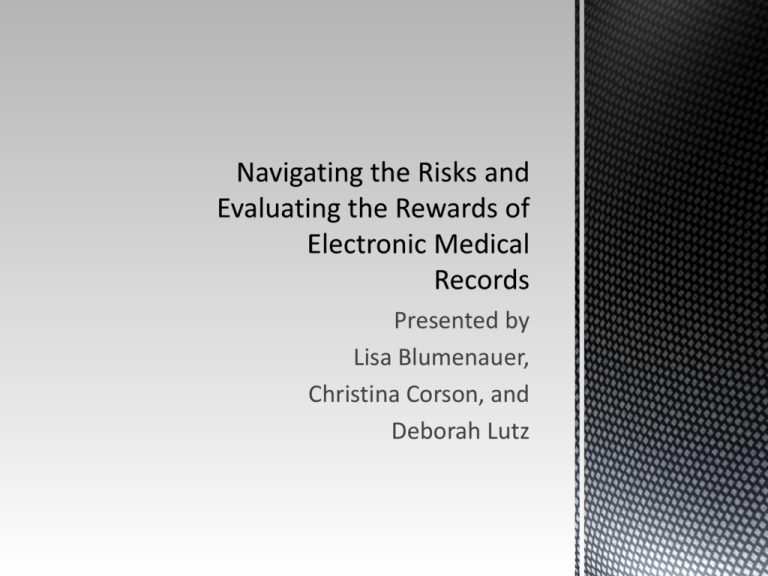
Presented by Lisa Blumenauer, Christina Corson, and Deborah Lutz Introduction Electronic Medical Records (EMRs) serve as a foundation for an overall comprehensive health information technology (IT) system. The capabilities that the EMR would incorporate are clinical documentation, health information, results management, order-entry management, clinical decision support, electronic communication and connectivity, patient support, administrative processes, reporting and disease surveillance. The physician’s notes can be entered into standardized formats fostering a more complete document. Images can be captured from computerized picture archive systems and may be transmitted to physicians at remote and various locations. Computerized physician order entry systems allow the physicians to order labs, pharmacy and radiology services electronically, therefore reducing time for delivery of medical records and orders. EMRs may provide physicians with electronic reminders, alerts to allergies to medications, contraindications to medication, and access to protocols and clinical guidelines. President George W. Bush called for an EMR for most citizens by the year 2014 (Korbin and Quattrone, 2007). He established a new office within the U.S. Department of Health and Human Services – The Office of the National Coordinator for Health Information Technology. This individual would coordinate and promote health IT. The office identified four goals to guide the transition of paper medical records and EMRs in both private and public health offices (Korbin and Quattrone, 2007). FourGoals to Guide the Transition into EMRs The adoption of EMRs for most citizens. The development of a secure EMR network to allow the exchange of health information among clinicians. The use of personal health records among patients. The improvement of public health through quality measurement and research. The implementation of EMRs can improve the quality of care though the instant retrieval and exchange of medical information and offers many advantages for coordination of healthcare. EMRs can decrease re-testing (which saves charges), review results without waiting for release of information from another source, monitor quality improvement results, increase patient participation and satisfaction, and increase accountability form hospitals, providers employers and payers (Licht, 2004). EMRs pose less risk than multiple medical histories in different locations, all with possibly different information. EMRs improve patient care by ensuring that the correct information is retrievable and legible (Licht, 2004). Despite all the potential benefits of the use of health IT, there are no current estimates of the adoption of health information technology across the U.S. Methods to speed the adoption of EMRs have received support among U.S. policymakers. The American Recovery and Reinvestment Act of 2009 has made the promotion of a national, interoperable health information system a priority (Jha, et al., 2009). Health and Human Services (HHS) delivers a Framework for Strategic Action titled “The Decade of Health Information Technology: Delivering Consumer-centric and Information-rich Health Care”, which identifies the current physician self-referral and anti-kickback protections as a significant obstacle and recommended their alteration suggesting HHS could explore safe harbors or expectations to these laws. The U.S. General Accountability Office (GAO) issued a report entitled “HHS’s Efforts to Promote Health Information Technology and Legal Barriers to Its Adoption,” stating despite HH’s efforts to implement new information technologies, HHS has done little to deal with laws that may inhibit the adoption of EMRs (Danello, 2006). The Health Insurance Portability and Accountability Act (HIPAA) enacted by the U.S. Congress in 1996 is massive in scope with five separate Titles. Two of the Titles are important for the covered entities of health care plans, clearinghouses and providers. If a software vendor is HIPAA compliant, you need to be aware of which rule they are compliant. Requirements are more detailed with the enactment of the Health Information Technology for Economic and Clinical Health Act (HITECH Act 2009) as part of The American Recovery and Reinvestment Act of 2009 (ARRA). Together these Acts form the basis for stimulus funds when “meaningful use” is met. The HITECH Act focuses on the establishment of a national health infrastructure and on providing incentives for the adoption of EMRs. In addition, provides more strict privacy protections. Currently, there are significant civil and potential criminal penalties as well as the potential for stimulus incentives to be denied for noncompliance. An estimated 85,000 medical lawsuits are filed annually. One of the many benefits to adopting EMRs is the potential to prevent medical malpractice incidents and medical errors (Lynn, 2010). By providing better documentation, automatically checking for medication effects and drug interactions, providing failsafe systems to track test results and follow up with patients, EMRs can reduce the risk of malpractice. The Office of the National Coordinator for Health Information Technology (ONC) issued a final rule to create a permanent certification program for health information technology on January 3, 2010 (Merril, 2011). According to this rule, the ONC will use the permanent certification program to authorize organizations to certify EMR tools, such as complete EMRs and or EMR components beginning Jan 1, 2012. Some features of the permanent certification program include accreditation by an ONC-Approved Accreditor (ONC-AA) in order to become Authorized Certification Bodies to test and or certify health IT. ONC-AA will be requiring to renew their statuses every three years (Merril, 2011). The laws that govern the confidentiality of health care information require proper system and data security. If the system is lacking in security, operation, or maintenance, a court could determine that the records stored on that system are not sufficiently reliable to be admissible in a legal proceeding (Merril, 2011). Healthcare providers have seen improvements in the delivery of care as a result of health IT, obstacles associated with organizations readiness still exist. Two major obstacles in the development and dissemination of EMR networks area the federal anti-kickback statute and the so-called “Stark” law, named after U.S. Representative Fortney Stark (DCal), prohibiting physician self-referral (Danello, 2006). The anti-kickback statute included a number of regulatory “safe harbors” applicable to EMRs (Merril, 2011). If an arrangement fits within a safe harbor, it is immune from attack under the statute. Failure to comply with all the requirements of a safe harbor does not mean the arrangement is illegal, but rather that it is subject to a facts and circumstances analysis. Practical limitations make it difficult to structure an EMR to fit within the existing anti-kickback safe harbors. One approach to limit access to electronic records is to maintain two levels of information, one with easy access for basic information and another with limited access with more sensitive information. Another options require the entry of special codes or passwords and/or data encryption and compression techniques. Advanced technology also permits biometrics-based authentication, which relies on physical characteristics of the user, such as fingerprints or voice patterns. New risks for malpractice. Data loss or destruction. Inappropriate corrections to the medical record. Inaccurate data entry. Unauthorized access. Errors related to problems that arise during the transition to EMRs. The laws have not kept up with the pace of the technological advances of EMRs. If statutes haven’t been updated in a particular state, an EMR may not technically comply with the law. Inadequate security of confidential health care information can result in severe emotional, financial, or adverse physical consequences for the patient which could result in costly litigation and damages. Excessive restrictions may prevent a health care provider from retrieving essential information when the patient needs it. Any provider that maintains or accesses EMRs must adopt and implement appropriate policies, rules and regulations to govern their access and use to ensure their availability and integrity over time (Lynn, 2010). Lack of physician participation can lead to implementation failure (Burchill, 2010). An outdated organizational strategic plan can lead to confusion of priorities based on prior facility planning paradigms (Burchill, 2010). Vendor’s software may not have a sustainability plan or may not continue in the health care marketplace (Burchill, 2010). We have provided evidence of how the presence of electronic laws affects the adoption of EMRs. Since the American Recovery and Reinvestment Act has made the promotion of a national and interoperable health information system a priority, health care organizations must be prepared to meet the ambitious deadlines and transform the coordination of care through EMRs. One side would assume that the use of EMRs may facilitate a hospitals defense, by providing a broader and more substantial standard of documentation. On the other side, it seems possible that the increase of available evidence by the plaintiff’s attorney may increase the medical malpractice risk associated with the adoption of EMRs. Several obstacles such as risk for malpractice, data entry errors, unauthorized access, litigation, and physician and organization alignment will have to be overcome. Once these obstacles have been tackled, we feel the adoption of EMRs will result in better quality of care and improved patient safety. Therefore, we are in favor of adopting the use of EMRs. References: Burchell, K.R. (2010). ARRA and meaningful use: is your organization ready? Journal of Healthcare Management, 55(4), 232-235. Danello, P.F. (2006, September). Preparing for interoperability: EMR and the law. Retrieved from http://www.healthmgttech.com/index.php/solutions/electronicmedical-records/preparing-for-interoperability-ehrs-and-the-law.html Jha, A.K., DesRoches, C.M., Campbell, E.G., Donelan, K., Rao, S.R., Ferris, T.G., Shields, A., Rosenbaum, S., and Blumenthal, D. (2009). Use of electronic health records in U.S. hospitals. Retrieved from http://www.nejm.org/doi/full/10.1056/ NEJMsa0900592#t=abstract Korbin, J.B. and Quattrone, M.S. (2007, June 20). Litigation in the decade of electronic health records. Retrieved from http://www.law.com/isp/ni/ PubArticleFriendlyNJ.isp?id =1181293530458 Licht, T. (2004, September 19). Electronic medical records - health care's next challenge in cyberspace. Retrieved from http://library.findlaw.com/2004/Sep/ 19/133570.html Lynn, J. (2010, December 29). Hippa lawsuit-phi by un-encrypted e-mail. Retrieved from http://www.emrandhipaa.com/category/hipaa-lawsuits/ Merril, M. (2011, January 04). Healthcare IT news . Retrieved from "http://www.mmsend53.com/link.cfm?r=624943089&sid=11998276&m=121242 0&u=ACHE&s=http://healthcareitnews.com/news/onc-issues-final-rulepermanent-certification-program Showalter, J.S. (2007) The law of healthcare administration, Chicago, IL: Health Administration Press.
